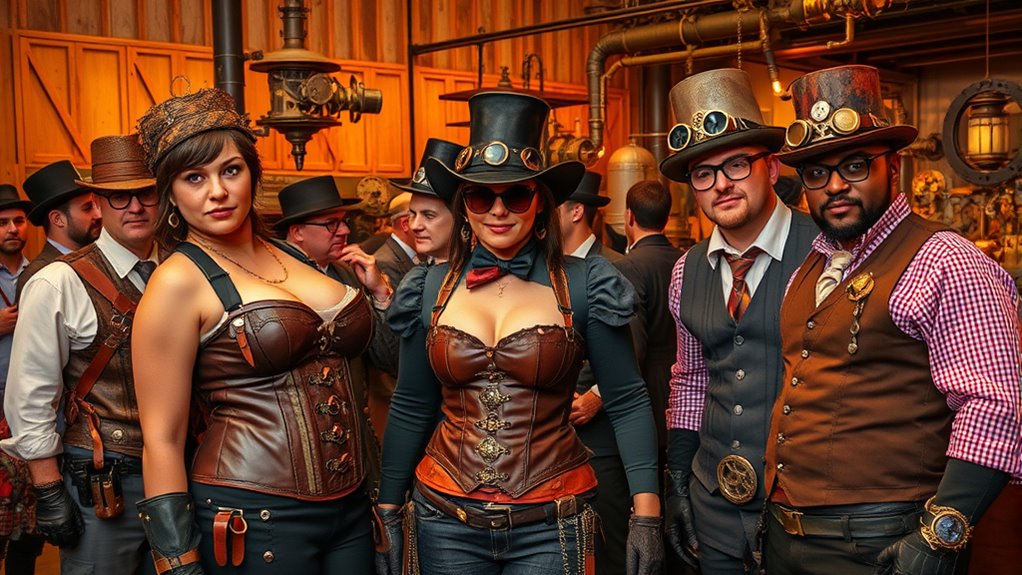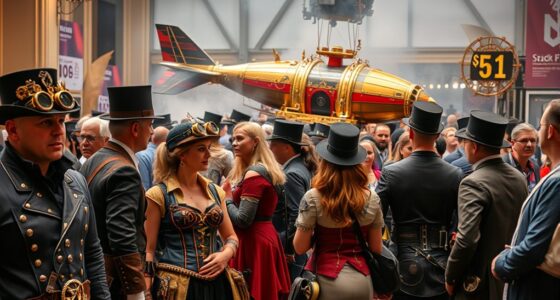You’ll find that steampunk’s origins stem from Victorian-era literature, where writers like H.G. Wells and Jules Verne imagined futuristic gadgets within elegant, mechanical worlds. This blend of technological optimism and ornate design inspired a fascination with steam-powered inventions and Victorian style. Over time, these themes shifted from stories to a cultural movement, blending fashion, art, and fandom. If you keep exploring, you’ll discover how this imaginative mix continues to influence modern subcultures today.
Key Takeaways
- Steampunk originated from Victorian-era science fiction literature imagining advanced machinery and futuristic worlds.
- Writers like H.G. Wells and Jules Verne popularized themes of invention and exploration influencing the genre.
- The visual style evolved from Victorian aesthetics combined with mechanical gadgets, inspiring fashion and design.
- The subculture emerged in the 1980s as enthusiasts embraced Victorian-inspired attire and steampunk-inspired art.
- Steampunk as a cultural movement celebrates ingenuity, blending historical innovation with literary imagination into a vibrant community.

Have you ever wondered where the steampunk aesthetic and philosophy originated? It all begins with a fascination for Victorian innovations and literary influences that shaped the early ideas behind this unique genre. During the 19th century, the Victorian era was a time of rapid technological progress. Steam-powered machinery, intricate clockwork devices, and groundbreaking inventions transformed daily life. These innovations weren’t just practical; they captured imaginations and inspired visions of a future built on steam and metal. It’s this era of technological optimism that forms the backbone of steampunk’s aesthetic, blending the old-world charm of Victorian design with the wonder of mechanical invention.
At its core, steampunk draws heavily on literary influences from that same period. Writers like H.G. Wells and Jules Verne created stories that envisioned futuristic technologies powered by steam, often set in elaborately detailed worlds that reflected Victorian society’s elegance and complexity. Their stories didn’t just entertain—they sparked imaginations and planted seeds for a subculture that would grow decades later. These authors depicted machines and gadgets that seemed ahead of their time, combining science with fantasy. Their stories provided a blueprint for the creative worlds later embraced by steampunk enthusiasts, who sought to reimagine history with a twist of technological fantasy.
The Victorian innovations and literary influences continue to resonate in steampunk culture today. The aesthetic is characterized by brass gadgets, gears, cogs, corsets, waistcoats, and ornate machinery, all echoing the design sensibilities of the era. Meanwhile, the stories inspired by Victorian science fiction serve as a foundation for modern steampunk narratives—adventures of inventors, explorers, and rebels in worlds where steam-powered technology reigns supreme. This connection to history and literature makes steampunk more than just fashion or art; it’s a way to celebrate the ingenuity and optimism of a bygone era while imagining new possibilities.
In essence, the origins of steampunk lie in a blend of Victorian innovations that propelled society forward and the enthralling stories that imagined a future shaped by steam and gears. That blend created a rich tapestry of ideas, aesthetics, and philosophies that still influence the subculture today. When you see someone dressed in Victorian-inspired attire or marvel at intricate mechanical devices, you’re witnessing a living homage to a time when technological wonder and literary imagination went hand in hand, laying the groundwork for the vibrant steampunk community we know now.
Frequently Asked Questions
How Did Steampunk Influence Modern Fashion Trends?
Steampunk influences your modern fashion by blending Victorian aesthetics with industrial motifs, creating a unique retro-futuristic style. You’ll see it in tailored coats, corsets, goggles, and metallic accessories that evoke a vintage yet innovative vibe. This trend encourages you to mix old-world charm with industrial elements, making your look both imaginative and stylish. Steampunk’s creative fusion inspires countless fashion pieces, allowing you to express individuality through a blend of history and technology.
Are There Specific Geographic Regions Central to Steampunk Culture?
You’ll find steampunk thriving in geographic hubs like Portland, Denver, and London, where regional influences blend with creative spirit. Imagine these cities as steam-powered engines, fueling a vibrant subculture that celebrates Victorian aesthetics and futuristic innovation. These hubs foster community events, conventions, and artisans, making them central to steampunk culture worldwide. Their unique blend of history and modernity keeps the movement alive and evolving, attracting enthusiasts everywhere.
What Are Common Materials Used in Steampunk Craftsmanship?
You’ll often find Victorian brass and leather accessories in steampunk craftsmanship. These materials give your creations that authentic, vintage feel. Brass is perfect for gears, cogs, and decorative accents, while leather adds a rugged, industrial touch to accessories like belts, goggles, and jewelry. Combining these elements helps you craft unique, intricate pieces that embody the steampunk aesthetic, blending Victorian elegance with industrial innovation seamlessly.
How Does Steampunk Relate to Other Alternative History Genres?
You’ll find that steampunk relates closely to other alternative history genres through its focus on alternative history narratives, imagining worlds where Victorian technology advances differently. It often features genre crossover influences, blending science fiction, fantasy, and historical elements. This fusion creates a unique aesthetic and storytelling style, allowing you to explore imaginative worlds that challenge traditional timelines while embracing Victorian-inspired design and innovation.
Can Steampunk Themes Be Integrated Into Digital Media and Gaming?
Imagine stepping into a virtual reality world where gears, brass, and Victorian fashion blend seamlessly—steampunk themes fit perfectly into digital media and gaming. You can create cyberpunk crossover experiences or virtual worlds that evoke steampunk aesthetics. Developers are already experimenting with steampunk-inspired environments, showcasing how this genre’s intricate design and historical flair enhance immersive gameplay and storytelling, making steampunk a vibrant part of the digital age.
Conclusion
As you immerse yourself in steampunk’s rich history, you realize it’s more than just gears and goggles—it’s a rebellion against the mundane, a celebration of imagination that’s timeless. From Victorian fiction to today’s vibrant subculture, it reminds you that innovation and creativity constantly collide, even in an era with Wi-Fi and robots. So, next time you see a clockwork accessory, remember, you’re holding a piece of history that’s still ticking, defying the march of time.









